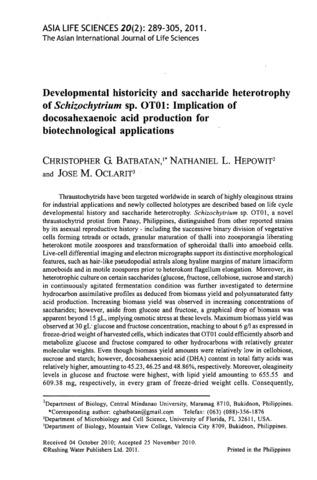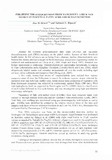Developmental historicity and saccharide heterotrophy of Schizochytrium sp. OT01: Implication of docosahexaenoic acid production for biotechnological applications
- Global styles
- MLA
- Vancouver
- Elsevier - Harvard
- APA
- Help

View/
Date
2011Page views
103ASFA keyword
AGROVOC keyword
Taxonomic term
Geographic names
Metadata
Show full item record
Share
Abstract
Thraustochytrids have been targeted worldwide in search of highly oleaginous strains for industrial applications and newly collected holotypes are described based on life cycle developmental history and saccharide heterotrophy. Schizochytrium sp. OT01, a novel thraustochytrid protist from Panay, Philippines, distinguished from other reported strains by its asexual reproductive history - including the successive binary division of vegetative cells forming tetrads or octads, granular maturation of thalli into zoosporangia liberating heterokont motile zoospores and transformation of spheroidal thalli into amoeboid cells. Live-cell differential imaging and electron micrographs support its distinctive morphological features, such as hair-like pseudopodial astrals along hyaline margins of mature limaciform amoeboids and in motile zoospores prior to heterokont flagellum elongation. Moreover, its heterotrophic culture on certain saccharides (glucose, fructose, cellobiose, sucrose and starch) in continuously agitated fermentation condition was further investigated to determine hydrocarbon assimilative profiles as deduced from biomass yield and polyunsaturated fatty acid production. Increasing biomass yield was observed in increasing concentrations of saccharides; however, aside from glucose and fructose, a graphical drop of biomass was apparent beyond 15 gL, implying osmotic stress at these levels. Maximum biomass yield was observed at 30 gL- glucose and fructose concentration, reaching to about 6 g/l as expressed in freeze-dried weight of harvested cells, which indicates that OT01 could efficiently absorb and metabolize glucose and fructose compared to other hydrocarbons with relatively greater molecular weights. Even though biomass yield amounts were relatively low in cellobiose, sucrose and starch; however, docosahexaenoic acid (DHA) content in total fatty acids was relatively higher, amounting to 45.23, 46.25 and 48.86%, respectively. Moreover, oleagineity levels in glucose and fructose were highest, with lipid yield amounting to 655.55 and 609.38 mg, respectively, in every gram of freeze-dried weight cells. Consequently, DHA yield was significantly higher in both glucose and fructose, reaching respectively to 492.04 and 478.18 mg per liter of nutrient broth, which indicates higher absorption and metabolism efficiency of monosaccharides into fatty acids.
Keywords
docosahexaenoic acid saccharide heterotrophy Schizochytrium sp. OT01 thraustochytrids biotechnology metabolism efficiency polyunsaturated fatty acids thraustochytridsSuggested Citation
Batbatan, C., Hepowit, N., & Oclarit, J. M. (2011). Developmental historicity and saccharide heterotrophy of Schizochytrium sp. OT01: Implication of docosahexaenoic acid production for biotechnological applications. Asia Life Sciences , 20(2), 289-305. http://hdl.handle.net/10862/6461
Type
ArticleISSN
0117-3375Collections
- Journal Articles [1229]
Related items
Showing items related by title, author, creator and subject.
-
Enrichment potential of HUFA-rich thraustochytrid Schizochytrium mangrovei for the rotifer Brachionus plicatilis
Estudillo-del Castillo, Chona; Gapasin, Rolando S.; Leaño, Eduardo M. (Elsevier, 2009)An enrichment experiment was performed to evaluate the changes in lipid and essential fatty acid contents of the rotifer Brachionus plicatilis fed with freeze-dried cells of tropical thraustochytrid Schizochytrium mangrovei ... -
Use of thraustochytrid Schizochytrium sp. as source of lipid and fatty acid in a formulated diet for abalone Haliotis asinina (Linnaeus) juveniles
de la Peña, Milagros R.; Teruel, Myrna B.; Oclarit, Jose M.; Amar, Mary Jane A.; Ledesma, Ellen Grace T. (Springer Verlag, 2016)The effects of using thraustochytrid Schizochytrium sp. as source of lipid and fatty acids in a formulated diet on growth, survival, body composition, and salinity tolerance of juvenile donkey’s ear abalone, Haliotis ... -
Philippine thraustochytrids from mangroves: A rich new source of essential fatty acids for human nutrition
Oclarit, Jose M.; Hepowit, Nathaniel L. (Marine Science Institute, University of the Philippines, 2007)







